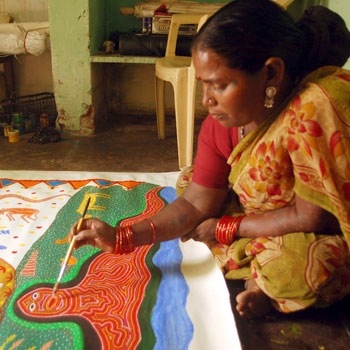Bhuri Bai
Bhuri Bai grew up in the Jhabua district on the Madhya Pradesh-Gujarat border. J Swaminathan identified her as a potential artist nearly three decades ago, when she was a 20-year-old daily-wage labourer. She picks up clues from the arts of embroidery as well as ritual narratives; her images shuttle between the intimate and the cosmic. This is especially evident in paintings where she depicts stags whose antlers grow into forests, their bodies distinctively patterned after desert dunes or river wavelets. She returns, often, to variations on the Tree of Life motif, playfully annotating its mythic presence with owls that stand on stilt-legs, timid snakes, and high-spirited elephants.
Bhuri Bai demonstrates a lively and witty eye for observed detail, veining her observations with allegorical or parabolic intent. In one of her paintings, long-necked birds with elegant beaks and crests like cockades dip into a stream to pluck fish from the shallow waters; instead, they risk being bitten by an irate crab. Her experience of the metropolis informs some of her works, in which airplanes frolic like river dolphins. In one of her finest works, Bhuri Bai dwells on a turtle that has just laid her eggs. She is threatened by crocodiles that swim around her; one of them snatches an egg from her glowing yellow cache. This aquatic mandala, dominated by the conflict between female creators and male predators, speaks directly of nature while proposing an allegory of the despoliation of the hinterlands by the forces of industrial and mercantile exploitation.
Bhuri Bai demonstrates a lively and witty eye for observed detail, veining her observations with allegorical or parabolic intent. In one of her paintings, long-necked birds with elegant beaks and crests like cockades dip into a stream to pluck fish from the shallow waters; instead, they risk being bitten by an irate crab. Her experience of the metropolis informs some of her works, in which airplanes frolic like river dolphins. In one of her finest works, Bhuri Bai dwells on a turtle that has just laid her eggs. She is threatened by crocodiles that swim around her; one of them snatches an egg from her glowing yellow cache. This aquatic mandala, dominated by the conflict between female creators and male predators, speaks directly of nature while proposing an allegory of the despoliation of the hinterlands by the forces of industrial and mercantile exploitation.
